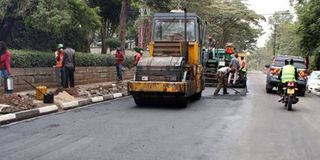Work hard to ensure Nairobi regains ‘green city in the sun’ status

Contractors re-carpet part of Nairobi's State House Road on July 8, 2015. PHOTO | JEFF ANGOTE | NATION MEDIA GROUP
What you need to know:
- The most recent loss are the trees along parts of Argwings Kodhek and Ngong roads, while future plans include the construction of a raised railway through the Nairobi National Park — the world’s only game reserve found within a major city.
- The other problem with such constructions is noise pollution.
- Clearly, the building of new roads and the widening of old ones have helped ease increasing levels of congestion in the city.
When I first travelled to Nairobi as a tourist in 1999, I was struck by how green the city was, with avenues of purple jacarandas, numerous parks, and the beautiful Arboretum.
However, with each trip since, trees and small houses have been replaced with apartment blocks, offices and wider roads. As a result, the city is hotter, dustier and uglier.
The most recent loss are the trees along parts of Argwings Kodhek and Ngong roads, while future plans include the construction of a raised railway through the Nairobi National Park — the world’s only game reserve found within a major city.
Clearly, some construction has been, and is, needed to provide offices for businesses, housing for a burgeoning middle class, and to help ease congestion.
However, one cannot help but wonder whether all of these projects are necessary, whether they could have been planned differently, and whether they could go hand-in-hand with better protection of the city’s green status.
Take the case of the construction of the Nairobi-Naivasha standard gauge railway. The current plan is to build the section through the Nairobi National Park along a bridge to minimise the effect on local flora and fauna. However, the scale of the construction will clearly still affect the park long into the future.
EXPENSIVE APARTMENTS
According to media reports, the route was chosen because it was cheaper than any other by around Sh200 million. This may sound like a lot, but — if reports that the entire Nairobi-Naivasha section will cost somewhere between Sh100 billion and over Sh150 billion are correct — then the savings made by going through the park are only 0.1 per cent or 0.2 per cent of the estimated total cost of the project.
In turn, while Nairobi residents need housing, it is questionable whether the large and relatively expensive apartments built in areas such as Kilimani and Kileleshwa are what is required.
Indeed, according to a report in the Kenya Homes Guide last year, normal occupancy levels for apartment blocks in the city is only 60 to 70 per cent; with rumours of much lower rates in some of the upper middle class areas. The problem is that there is a surplus of high-end housing, which most Nairobians simply cannot afford.
The other problem with such constructions is noise pollution. This includes the establishment of new clubs, which operate in developments such as the Galana Plaza in Kilimani. In these cases, the problem often seems to be a failure to impose existing sound regulations.
Finally, we have road construction. Clearly, the building of new roads and the widening of old ones have helped ease increasing levels of congestion in the city. However, there is a limit to what new roads can do to solve the traffic problem in the face of increased car ownership.
A more durable solution would be to encourage people to take public transport. For example, in London, almost no one drives to work even if they are a high-flying lawyer or top civil servant. This is due to the number of bus, underground and train routes, and the frequency with which these services run.
However, it is also due to a policy to charge people £11.50 per day (Sh1,400) to drive within the ‘congestion charge zone’ on weekdays, and to the city’s high parking fees.
The point is that not all of the construction that has taken place in Nairobi over the past 20 years is necessary, while much of it fails to meet the city’s own regulations. More thought, therefore, needs to be given to the city’s future.
Do the benefits of having a national park justify the cost of building a railway around (rather than through) this public good? Is there an argument for improving the quality and safety of public transport, and of discouraging people from driving to work?
And should building permits be denied if there is no evidence that the type of housing or offices to be constructed are actually needed? These are all questions that demand debate if the city wants to retain — or perhaps more appropriately regain — its status as the ‘green city in the sun’.
Gabrielle Lynch is an associate professor of Comparative Politics, University of Warwick, UK. [email protected]; @GabrielleLynch6





